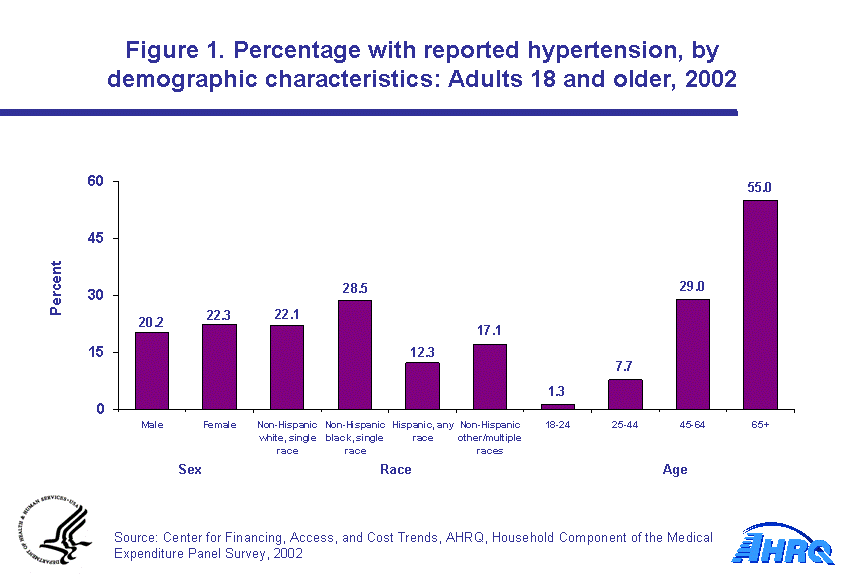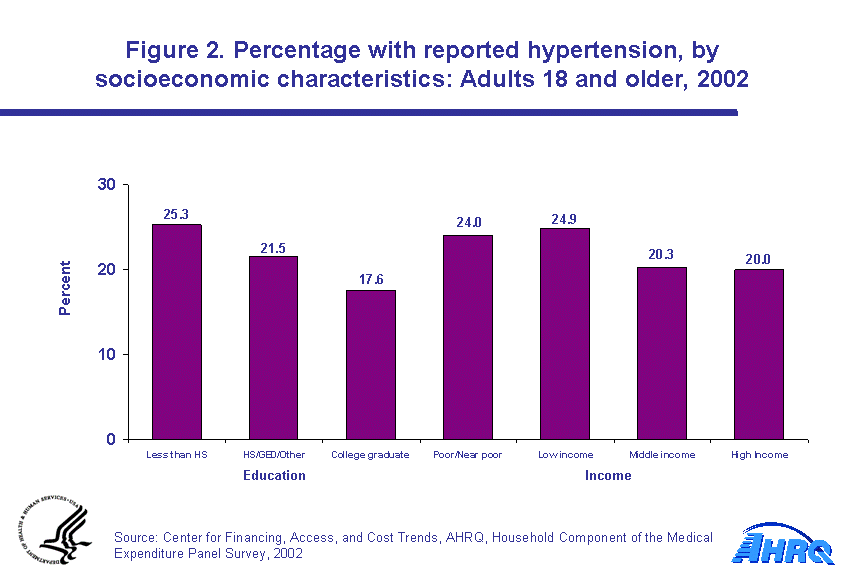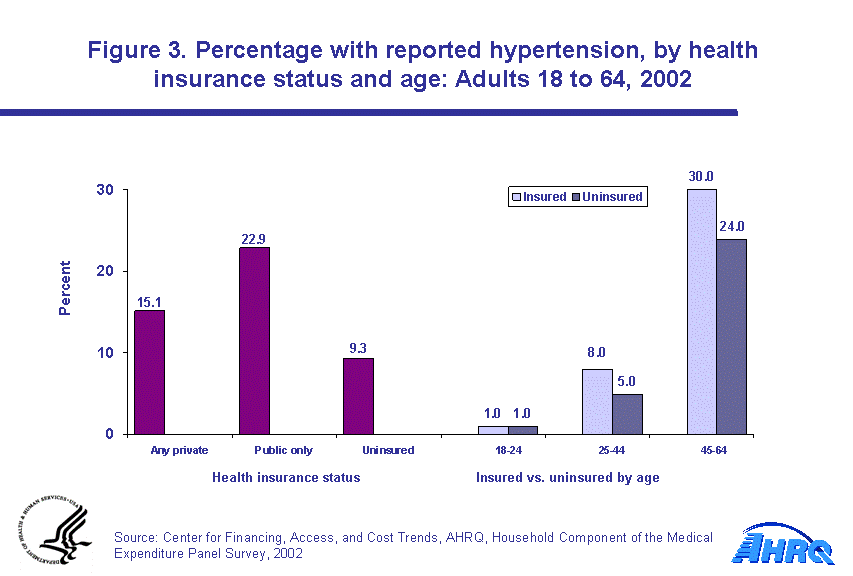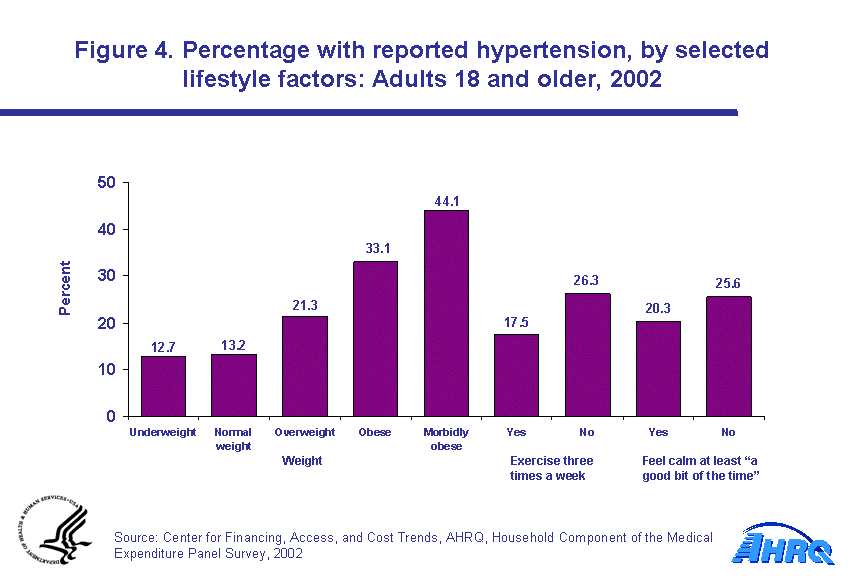
|
|
Font Size:
|
||||
|
|
|
|
||||
STATISTICAL BRIEF #59:
Hypertension in America, 2002: Estimates for the U.S. Civilian Noninstitutionalized Population Ages 18 and Older
Highlights
- 21.3 percent or 45.3 million adults reported having been told at two or more different health care visits that they have hypertension.
- The percentage of non-Hispanic blacks ever diagnosed with hypertension was higher than for non-Hispanic whites (28.5 percent and 22.1 percent, respectively), while the percentage among Hispanics was lower than for non-Hispanic whites (12.3 percent and 22.1 percent, respectively).
- The percentage of adults ever diagnosed with hypertension was 1.4 times greater for those with less than a high school education than for those with a college education (25.3 percent and 17.6 percent, respectively).
- The percentage of overweight, obese, and morbidly obese (combined) adults ever diagnosed with hypertension was twice that of healthy weight adults (26.7 percent and 13.2 percent, respectively).
- Among adults 18 to 64 years old, uninsured adults were substantially less likely to have ever been diagnosed with hypertension than adults covered only by public health insurance (9.3 percent and 22.9 percent, respectively), or covered by any private health insurance (9.3 percent and 15.1 percent, respectively).
Introduction
Hypertension, commonly referred to as high blood pressure, is a serious medical condition which, if not controlled, can lead to more serious cardiovascular conditions. Data from the Household Component of the 2002 Medical Expenditure Panel Survey (MEPS-HC) show that an estimated 21.3 percent or 45.3 million adults 18 years old and older had been told by a health care professional at two or more different medical visits that they had hypertension. This estimate is based on reports for all household members by a single household respondent during the MEPS household interview, and it only includes diagnosed hypertension. An estimated 31 percent of adults with hypertension are unaware they have the condition.*
Diagnosed hypertension as reported by household respondents in the MEPS is not distributed evenly across all subgroups of adults. Specifically, the percentage of adults with diagnosed hypertension differs by gender, race/ethnicity, age, educational attainment, family income, and insurance status.
Lifestyle factors, such as exercise, weight control, and stress reduction, can affect the risk and impact of hypertension. MEPS data show that regular exercise, maintaining a healthy weight, and having a low level of stress are all positively correlated with lower rates of diagnosed hypertension.
All differences between estimates discussed in the text are statistically significant at the 0.05 level.
Findings
Demographic and Socioeconomic Characteristics
In 2002, slightly more adult women than men had ever been diagnosed with hypertension (22.3 percent and 20.2 percent, respectively) (figure 1). The difference between men and women, however, was greater in older age groups. For example, among adults 65 years and older, 57.3 percent of women had a hypertension diagnosis compared to 51.8 percent of men (data not shown in figure).
The percentage of adults ever diagnosed with hypertension also varied across various race/ethnic groups and by age (figure 1). The percentage was higher among non-Hispanic black adults (28.5 percent) compared to non-Hispanic white adults (22.1 percent), while the rate among Hispanics (12.3 percent) was lower than that of non-Hispanic whites and non-Hispanic blacks. A positive relationship existed between diagnosed hypertension and age (1.3 percent among persons 18 to 24 years old and 55.0 percent among persons 65 years and older).
The percentage of adults ever diagnosed with hypertension also differed according to selected socioeconomic characteristics (figure 2). The percentage among adults with less than a high school education was 1.4 times greater than for adults with a college education (25.3 percent and 17.6 percent, respectively). Differences also existed by income (24.9 percent among low income adults versus 20.0 percent among high income adults).
Health Insurance Status
Among adults 18 to 64 years old, the likelihood of ever being diagnosed with hypertension was lowest among uninsured adults (9.3 percent) and highest among those covered only by public insurance (22.9 percent). Rates for adults with any private health insurance were in between (15.1 percent) (figure 3).
Figure 3 shows that as age increases, the difference in the rate of ever being diagnosed with hypertension, between insured and uninsured adults, widens.
Lifestyle Factors
Healthy lifestyles can help reduce the risk and impact of hypertension. Figure 4 shows that the percentage of adults ever diagnosed with reported hypertension increased progressively with increasing body weight (as reported by the household respondent). The percentage of overweight, obese, and morbidly obese (combined) adults ever diagnosed with hypertension was twice that of normal weight adults (26.7 percent and 13.2 percent, respectively). Specifically, the percentage of overweight adults with diagnosed hypertension was 21.3 percent compared to 13.2 percent among normal weight adults. More striking, however, was the 3.3 times higher percentage of morbidly obese adults ever diagnosed with hypertension compared to normal weight adults (44.1 percent and 13.2 percent, respectively). About 58 percent of the adults with diagnosed hypertension were advised by a health professional to eat fewer high-fat or high-cholesterol foods (data not shown in figure).
The percentage of adults ever diagnosed with hypertension also varied by exercise activity and stress level. The percentage among adults who reported that they spent half an hour or more in moderate or vigorous physical activity at least three times a week was lower than among persons not reporting this level of exercise activity (17.5 percent and 26.3 percent, respectively). About 61 percent of the adults with hypertension were advised by a health professional to exercise more (data not shown in figure). Regarding stress, 20.3 percent of adults who reported that they felt calm at least "a good bit of the time" had been diagnosed with hypertension compared to 25.6 percent of adults that at best reported feeling calm "some of the time."
Considering the above lifestyle factors together, 18.4 percent of all adults reported that they exercised regularly, had a normal weight, and felt calm at least "a good bit of the time"; the percentage that had been diagnosed with hypertension among this group was 11.6 percent, compared to 24.0 percent for the rest of the adult population (data not shown in figure).
The 2002 MEPS-HC data also show that 17.0 percent of adults who had ever been diagnosed with hypertension were current smokers and that about 66 percent of those had been advised by a doctor to quit smoking within the past 12 months (data not shown in figure).
Data Source
This Statistical Brief summarizes data concerning the prevalence of diagnosed hypertension in the United States during 2002 as reported in the 2002 MEPS-HC by the designated household respondent during the household interview (see HC-062: 2002 Full Year Population Characteristics public use file). The conditions data are from the Priority Conditions Section, which were administered in Round 3/5. Item nonresponse rates for the items reported in this brief ranged from 0 percent to 5.2 percent. No adjustments were made for item nonresponse.
Definitions/Methodology
Hypertension
The following question was used to identify persons with hypertension: "Were you told on two or more different visits that you had hypertension, also called high blood pressure?" The household respondent was asked this question about himself or herself and the other adults living in the household.
Body Mass Index (BMI)
- Underweight: BMI is less than 18.5
- Normal weight: BMI is between 18.5 and 24.9 inclusive
- Overweight: BMI is between 25.0 and 29.9 inclusive
- Obesity: BMI is between 30.0 and 39.9 inclusive
- Morbidly obese: BMI greater than or equal to 40.0
The following question from the Self-Administered Questionnaire was used as a measure for stress: "How much of the time during the past four weeks have you felt calm and peaceful? All of the time, most of the time, a good bit of the time, some of the time, a little of the time, or none of the time?" The assumption is that people reporting feeling calm and peaceful only some of the time, a little of the time, or none of the time are potentially experiencing unhealthy amounts of stress.
Education level
Respondents were asked to report the highest grade or year of schooling ever completed by each family member as of the date of the interview: not a high school graduate (grade less than 12), high school graduate/GED/other (grade 12 or equivalent or some college), and college graduate.
Poverty status
Each person in the survey sample was classified according to the total yearly income of his or her family. Within a household, all individuals related by blood, marriage, or adoption were considered to be a family. Personal income from all family members was summed to create family income.
Poverty status is the ratio of family income to the Federal poverty thresholds, which control for family size and age of the head of family. Categories are defined as follows:
- Poor/near poor: This refers to persons in families with incomes under 125 percent of the poverty line and also includes persons with negative income.
- Low income: This category includes persons in families with income over 125 percent through 200 percent of the poverty line.
- Middle income: This category includes persons in families with income over 200 percent through 400 percent of the poverty line.
- High income: This category includes persons in families with income over 400 percent of the poverty line.
Health insurance status was constructed hierarchically in the following order:
- Any private coverage: Private health insurance coverage was defined as nonpublic insurance that provided coverage for hospital and physician care (including Medigap coverage). TRICARE was considered private coverage.
- Public only coverage: Adults were considered to have public only health insurance coverage if they were not covered by private insurance, and they were covered by Medicare, Medicaid, or other public hospital and physician coverage.
- Uninsured: Adults classified as uninsured did not have public or private health insurance coverage. People covered only by noncomprehensive state-specific programs (e.g., Maryland Kidney Disease Program) or private single-service plans (e.g., coverage for dental or vision care only, coverage for accidents or specific diseases) were not considered to be insured.
About MEPS-HC
MEPS-HC is a nationally representative longitudinal survey that collects detailed information on health care utilization and expenditures, health insurance, and health status, as well as a wide variety of social, demographic, and economic characteristics for the civilian noninstitutionalized population. It is cosponsored by the Agency for Healthcare Research and Quality and the National Center for Health Statistics.
For more information about MEPS, call the MEPS information coordinator at AHRQ (301-427-1406) or visit the MEPS Web site at http://www.meps.ahrq.gov/.
References
For a detailed description of the MEPS-HC survey design, sample design, and methods used to minimize sources on nonsampling error, see the following publications:
Cohen, J. Design and Methods of the Medical Expenditure Panel Survey Household Component. MEPS Methodology Report No. 1. AHCPR Pub. No. 97-0026. Rockville, Md.: Agency for Health Care Policy and Research, 1997.
Cohen, S. Sample Design of the 1996 Medical Expenditure Panel Survey Household Component. MEPS Methodology Report No. 2. AHCPR Pub. No. 97-0027. Rockville, Md.: Agency for Health Care Policy and Research, 1997.
Suggested Citation
Carroll, W. Hypertension in America, 2002: Estimates for the U.S. Civilian Noninstitutionalized Population Ages 18 and Older. Statistical Brief #59. December 2004. Agency for Healthcare Research and Quality, Rockville, MD. http://www.meps.ahrq.gov/mepsweb/data_files/publications/st59/stat59.shtml
Footnote
* Burt, Vicki L., Paul Whelton, Edward J. Roccella, et al. "Prevalence of Hypertension in the U.S. Adult Population. Results from the Third National Health and Nutrition Examination Survey, 1988-1991." Hypertension vol. 25, no. 3, March 1995, pp. 305-313.
 |
||||||||||||||||||||||||||||||||||||||||||||||||||||
|
||||||||||||||||||||||||||||||||||||||||||||||||||||
|
|
||||||||||||||||||||||||||||||||||||||||||||||||||||
 |
||||||||||||||||||||||||||||||||||||||||||||||||||||
|
||||||||||||||||||||||||||||||||||||||||||||||||||||
|
|
||||||||||||||||||||||||||||||||||||||||||||||||||||
 |
||||||||||||||||||||||||||||||||||||||||||||||||||||
|
||||||||||||||||||||||||||||||||||||||||||||||||||||
|
|
||||||||||||||||||||||||||||||||||||||||||||||||||||
 |
||||||||||||||||||||||||||||||||||||||||||||||||||||
|
||||||||||||||||||||||||||||||||||||||||||||||||||||
|
|
||||||||||||||||||||||||||||||||||||||||||||||||||||


